The Identification of Manure Spreading on Bare Soil through the Development of Multispectral Indices from Sentinel-2 Data: The Emilia-Romagna Region (Italy) Case Study
Abstract
:1. Introduction
2. Materials and Methods
2.1. Study Area
2.2. Satellite Data
2.3. Ancillary Data
2.4. LMD Spectral Analysis
2.5. Spectral Comparison between Bare Soil and LMD
2.6. Spectral Index Development
2.7. MSI Threshold Identification
2.8. Performance Evaluation and Accuracy Methods
2.8.1. Correlation Analysis of the MSI, MNDWI, and NDVI
2.8.2. The OLR Tests
2.8.3. Accuracy
3. Results
3.1. LMD Spectral Analysis
3.2. Spectral Comparison between Bare Soil and LMD
3.3. Manure Spectral Index and Threshold Identification
3.4. Performance and Evaluation Accuracy Results
3.4.1. Correlation Analysis of the MSI, MNDWI, and NDVI
3.4.2. The OLR Tests
3.4.3. Confusion Matrix
4. Discussion
5. Conclusions
Author Contributions
Funding
Institutional Review Board Statement
Informed Consent Statement
Data Availability Statement
Acknowledgments
Conflicts of Interest
References
- Tornato, A.; Ricolfi, S.; Pirola, A.; Belluzzo, M.; Zanni Bertelli, V.; Sapio, S.; Dubbini, M.; Filipponi, F.; Alessandrini, C. A GIS-Based Approach for Manure-Spreading Monitoring within the Digital Agricultural Framework. Biol. Life Sci. Forum 2023, 27, 18. [Google Scholar] [CrossRef]
- Regolamento Regionale in Materia di Utilizzazione Agronomica Degli Effluenti di Allevamento, del Digestato e delle Acque Reflue; Decreto n.209, Regolamento Regionale n.3, Bollettino Ufficiale Anno 48, n.336; Regione Emilia-Romagna: Viale Aldo Moro, Italy, 15 December 2017.
- Piano di Utilizzazione Agronomica Degli Effluenti Zootecnici (PUA). Available online: https://www.arpae.it/it/temi-ambientali/suolo/agrozootecnia/pua (accessed on 19 February 2024).
- Ramankutty, N.; Mehrabi, Z.; Waha, K.; Jarvis, L.; Kremen, C.; Herrero, M.; Rieseberg, L.H. Trends in global agricultural land use: Implications for environmental health and food security. Annu. Rev. Plant Biol. 2018, 69, 789–815. [Google Scholar] [CrossRef] [PubMed]
- Dodin, M.; Levavasseur, F.; Savoie, A.; Martin, L.; Foulon, J.; Vaudour, E. Sentinel-2 satellite images for monitoring cattle slurry and digestate spreading on emerging wheat crop: A field spectroscopy experiment. Geocarto Int. 2023, 38, 1. [Google Scholar] [CrossRef]
- Kleinman, P.J.A.; Spiegal, S.; Liu, J.; Holly, M.; Church, C.; Ramirez-Avila, J. Managing Animal Manure to Minimize Phosphorus Losses from Land to Water. Anim. Manure Prod. Charact. Environ. Concerns Manag. 2020, 67, 201–228. [Google Scholar] [CrossRef]
- Liu, J.; Spargo, J.T.; Kleinman, P.J.A.; Meinen, R.; Moore, P.A., Jr.; Beegle, D.B. Water-Extractable Phosphorus in Animal Manure and Manure Compost: Quantities, Characteristics, and Temporal Changes. J. Environ. Qual. 2018, 47, 471–479. [Google Scholar] [CrossRef]
- Tzilivakis, J.; Warner, D.; Green, A.; Lewis, K. A broad-scale spatial analysis of the environmental benefits of fertiliser closed periods implemented under the nitrates directive in europe. J. Environ. Manag. 2021, 299, 113674. [Google Scholar] [CrossRef]
- Kim, D.K.; Kaluskar, S.; Mugalingam, S.; Arhonditsis, G.B. Evaluating the relationships between watershed physiography, land use patterns, and phosphorus loading in the bay of quinte basin, ontario, canada. J. Great Lakes Res. 2016, 42, 972–984. [Google Scholar] [CrossRef]
- Waller, D.M.; Meyer, A.G.; Raff, Z.; Apfelbaum, S.I. Shifts in precipitation and agricultural intensity increase phosphorus concentrations and loads in an agricultural watershed. J. Environ. Manag. 2021, 284, 112019. [Google Scholar] [CrossRef]
- Koelsch, R. Evaluating Livestock System Environmental Performance with Whole-Farm Nutrient Balance. J. Environ. Qual. 2005, 34, 149–155. [Google Scholar] [CrossRef]
- Long, C.M.; Muenich, R.L.; Kalcic, M.M.; Scavia, D. Use of manure nutrients from concentrated animal feeding operations. J. Great Lake. Res. 2018, 44, 245–252. [Google Scholar] [CrossRef]
- Dodin, M.; Smith, H.D.; Levavasseur, F.; Hadjar, D.; Houot, S.; Vaudour, E. Potential of sentinel-2 satellite images for monitoring green waste compost and manure amendments in temperate cropland. Remote Sens. 2021, 13, 1616. [Google Scholar] [CrossRef]
- Aguirre-Villegas, H.; Larson, R. Evaluating greenhouse gas emissions from dairy manure management practices using survey data and lifecycle tools. J. Clean. Prod. 2016, 143, 169–179. [Google Scholar] [CrossRef]
- Teenstra, E.D.; Vellinga, T.V.; Aktasaeng, N.; Amatayaku, W.; Ndambi, A.; Pelster, D.; Germer, L.; Jenet, A.; Opio, C.; Andeweg, K. Global Assessment of Manure Management Policies and Practices; Livestock Research Report; No. 844; Wageningen UR Livestock Research: Wageningen, The Netherlands, 2014; Available online: https://edepot.wur.nl/335445 (accessed on 19 February 2024).
- Meyer, D.; Price, P.L.; Rossow, H.A.; Silva del Rio, N.; Karle, B.M.; Robinson, P.H.; DePeters, E.J.; Fadel, J.G. Survey of dairy housing and manure management practices in California. J. Dairy Sci. 2011, 94, 4744–4750. [Google Scholar] [CrossRef] [PubMed]
- Sandars, D.L.; Audsley, E.; Canete, C.; Cumby, T.R.; Scotford, I.M.; Williams, A.G. Environmental benefits of livestock manure management practices and technology by life cycle assessment. Biosyst. Eng. 2003, 84, 267–281. [Google Scholar] [CrossRef]
- Shea, K.; Schaffer-Smith, D.; Muenich, R.L. Using remote sensing to identify liquid manure applications in eastern North Carolina. J. Environ. Manag. 2022, 317, 115334. [Google Scholar] [CrossRef] [PubMed]
- Pedrayes, O.D.; Usamentiaga, R.; Trichakis, Y.; Bouraoui, F. Remote sensing for detecting freshly manured fields. Ecol. Inform. 2023, 75, 102006. [Google Scholar] [CrossRef]
- Yang, C.C.; Prasher, S.O.; Whalen, J.; Goel, P.K. Pa—Precision agriculture: Use of hyperspectral imagery for identification of different fertilisation methods with decision-tree technology. Biosyst. Eng. 2002, 83, 291–298. [Google Scholar] [CrossRef]
- Wang, J. Satellite Mapping of Past Biosolids (Sewage Sludge) and Animal Manure Application to Agriculture Fields in Wood County. Master’s Thesis, Bowling Green State University, Bowling Green, OH, USA, 2009. Available online: http://rave.ohiolink.edu/etdc/view?acc_num=bgsu1245276797 (accessed on 19 February 2024).
- Ma, Q.; Yu, W.; Zhou, H. The relationship between soil nutrient properties and remote sensing indices in the phaeozem region of northeast China. In Proceedings of the 2010 Second International Conference on Computational Intelligence and Natural Computing, Wuhan, China, 13–14 September 2010; IEEE: Piscataway, NJ, USA, 2010; Volume 2, pp. 109–112. Available online: https://ieeexplore.ieee.org/document/5643777 (accessed on 19 February 2024).
- Romanko, M. Remote Sensing in Precision Agriculture: Monitoring Plant Chlorophyll, and Soil Ammonia, Nitrate, and Phosphate in Corn and Soybean Fields. Ph.D. Thesis, Bowling Green State University, Green, OH, USA, 2017. Available online: http://rave.ohiolink.edu/etdc/view?acc_num=bgsu1490964339514842 (accessed on 19 February 2024).
- Zhu, W.; Rezaei, E.E.; Nouri, H.; Yang, T.; Li, B.; Gong, H.; Lyu, Y.; Peng, J.; Sun, Z. Quick detection of field-scale soil comprehensive attributes via the integration of UAV and Sentinel-2b remote sensing data. Remote Sens. 2021, 13, 4716. [Google Scholar] [CrossRef]
- Fu, Y.; Yang, G.; Pu, R.; Li, Z.; Li, H.; Xu, X.; Song, X.; Yang, X.; Zhao, C. An overview of crop nitrogen status assessment using hyperspectral remote sensing: Current status and perspectives. Eur. J. Agron. 2021, 124, 126241. [Google Scholar] [CrossRef]
- Prasad, P.; Loveson, V.J.; Chandra, P.; Kotha, M. Evaluation and comparison of the earth observing sensors in land cover/land use studies using machine learning algorithms. Ecol. Inform. 2022, 68, 101522. [Google Scholar] [CrossRef]
- Mohajane, M.; Essahlaoui, A.; Oudija, F.; Hafyani, M.E.; Hmaidi, A.E.; Ouali, A.E.; Randazzo, G.; Teodoro, A.C. Land Use/Land Cover (LULC) Using Landsat Data Series (MSS, TM, ETM+ and OLI) in Azrou Forest, in the Central Middle Atlas of Morocco. Environments 2018, 5, 131. [Google Scholar] [CrossRef]
- Currit, N. Development of a remotely sensed, historical land-cover change database for rural Chihuahua, Mexico. Int. J. Appl. Earth Obs. Geoinf. 2005, 7, 232–247. [Google Scholar] [CrossRef]
- Jaihuni, M.; Khan, F.; Lee, D.; Basak, J.K.; Bhujel, A.; Moon, B.E.; Park, J.; Kim, H.T. Determining spatiotemporal distribution of macronutrients in a cornfield using remote sensing and a deep learning model. IEEE 2021, 9, 30256–30266. [Google Scholar] [CrossRef]
- Sistema Informativo Veterinario. Available online: https://www.vetinfo.it/ (accessed on 19 February 2024).
- ENERGIA: Impianti a Biomasse/Biogas-Aggiornamento 2020. Open Data Emilia-Romagna. Available online: https://dati.emilia-romagna.it/dataset/energia-impianti-a-biomasse-biogas-aggiornamento-2020 (accessed on 19 February 2024).
- Sentinel Copernicus; ESA. S2 Mission—Overview of Sentinel-2 Mission. Available online: https://sentinels.copernicus.eu/web/sentinel/missions/sentinel-2/overview (accessed on 19 February 2024).
- Sentinel Copernicus; ESA. S2 Applications—Overview of S2 Applications. Available online: https://sentinel.esa.int/web/sentinel/user-guides/sentinel-2-msi/processing-levels (accessed on 19 February 2024).
- Li, W.; Du, Z.; Ling, F.; Zhou, D.; Wang, H.; Gui, Y.; Sun, B.; Zhang, X. A Comparison of Land Surface Water Mapping Using the Normalized Difference Water Index from TM, ETM+ and ALI. Remote Sens. 2013, 5, 5530–5549. [Google Scholar] [CrossRef]
- Yu, Z.; Di, L.; Rahman, M.S.; Tang, J. Fishpond Mapping by Spectral and Spatial-Based Filtering on Google Earth Engine: A Case Study in Singra Upazila of Bangladesh. Remote Sens. 2020, 12, 2692. [Google Scholar] [CrossRef]
- Kobayashi, N.; Tani, H.; Wang, X.; Sonobe, R. Crop classification using spectral indices derived from Sentinel-2A imagery. J. Inf. Telecommun. 2020, 4, 67–90. Available online: https://www.tandfonline.com/doi/epdf/10.1080/24751839.2019.1694765?needAccess=true (accessed on 22 February 2024). [CrossRef]
- Medina-Lopez, E.; Ureña-Fuentes, L. High-Resolution Sea Surface Temperature and Salinity in Coastal Areas Worldwide from Raw Satellite Data. Remote Sens. 2019, 11, 2191. [Google Scholar] [CrossRef]
- ARPAE. CRITERIA-Modello di Bilancio Idrico e Sviluppo Colturale. Available online: https://www.arpae.it/it/temi-ambientali/meteo/scopri-di-piu/strumenti-di-modellistica/criteria (accessed on 19 February 2024).
- Regione Emilia-Romagna. Cartografie e Uso del Suolo di Dettaglio. Available online: https://www.regione.emilia-romagna.it/ (accessed on 11 May 2023).
- ISPRA. Uso, Copertura e Consumo di Suolo. Available online: https://www.isprambiente.gov.it/it/banche-dati/banche-dati-folder/suolo-e-territorio/uso-del-suolo (accessed on 11 May 2023).
- iColt. Arpae Servizio Idro-Meteo-Clima. 2022. Available online: https://sites.google.com/arpae.it/servizio-climatico-icolt/icolt2022 (accessed on 11 May 2023).
- ARPAE. Servizio Climatico iColt. Available online: https://sites.google.com/arpae.it/servizio-climatico-icolt (accessed on 19 February 2024).
- Nguyen, C.T.; Chidthaisong, A.; Kieu Diem, P.; Huo, L.Z. A Modified Bare Soil Index to Identify Bare Land Features during Agricultural Fallow-Period in Southeast Asia Using Landsat 8. Land 2021, 10, 231. [Google Scholar] [CrossRef]
- Villani, G.; Tomei, F.; Pavan, V.; Pirola, A.; Spisni, A.; Marletto, V. The iCOLT climate service: Seasonal predictions of irrigation for Emilia-Romagna, Italy. Meteorol. Appl. 2021, 28, e2007. [Google Scholar] [CrossRef]
- Rouse, J.W.; Haas, R.H.; Scheel, J.A.; Deering, D.W. Monitoring Vegetation Systems in the Great Plains with ERTS. In Proceedings of the 3rd Earth Resource Technology Satellite (ERTS) Symposium; Washington, DC, USA, 10–14 December 1973, NASA: Washington, DC, USA, 1974; Volume 1, pp. 48–62. Available online: https://ntrs.nasa.gov/citations/19740022614 (accessed on 19 February 2024).
- Divya, Y.; Gopinathan, P. Soil water content measurement using hyper-spectral remote sensing techniques. A case study from north-western part of Tamil Nadu, India. Remote Sens. Applic. Soc. Environ. 2019, 14, 1–7. [Google Scholar] [CrossRef]
- Xu, H. Modification of normalised difference water index (NDWI) to enhance open water features in remotely sensed imagery. Int. J. Remote Sens. 2006, 27, 3025–3033. [Google Scholar] [CrossRef]
- Congalton, R.G. A review of assessing the accuracy of classifications of remotely sensed data. Remote Sens. Environ. 1991, 37, 35–46. [Google Scholar] [CrossRef]
- Tukey, J.W. Exploratory Data Analysis; Addison-Wesley: Reading, MA, USA, 1977; Volume 2, Available online: https://scholar.google.com/scholar_lookup?&title=Exploratory%20Data%20Analysis&publication_year=1977&author=Tukey%2CJ.%20W (accessed on 19 February 2024).
- Congalton, R.G.; Mead, R.A. A Quantitative Method to Test for Consistency and Correctness in Photointerpretation. Photogramm. Eng. Remote Sens. 1983, 49, 69–74. Available online: https://scholars.unh.edu/faculty_pubs/1244/ (accessed on 19 February 2024).
- Rosenfield, G.H.; Fitzpatrick-Lins, K. A Coefficient of Agreement as a Measure of Thematic Classification Accuracy. Photogramm. Eng. Remote Sens. 1986, 52, 223–227. Available online: https://www.asprs.org/wp-content/uploads/pers/1986journal/feb/1986_feb_223-227.pdf (accessed on 19 February 2024).
- Landis, J.R.; Koch, G.G. The measurement of observer agreement for categorical data. Biometrics 1977, 33, 159–174. [Google Scholar] [CrossRef]

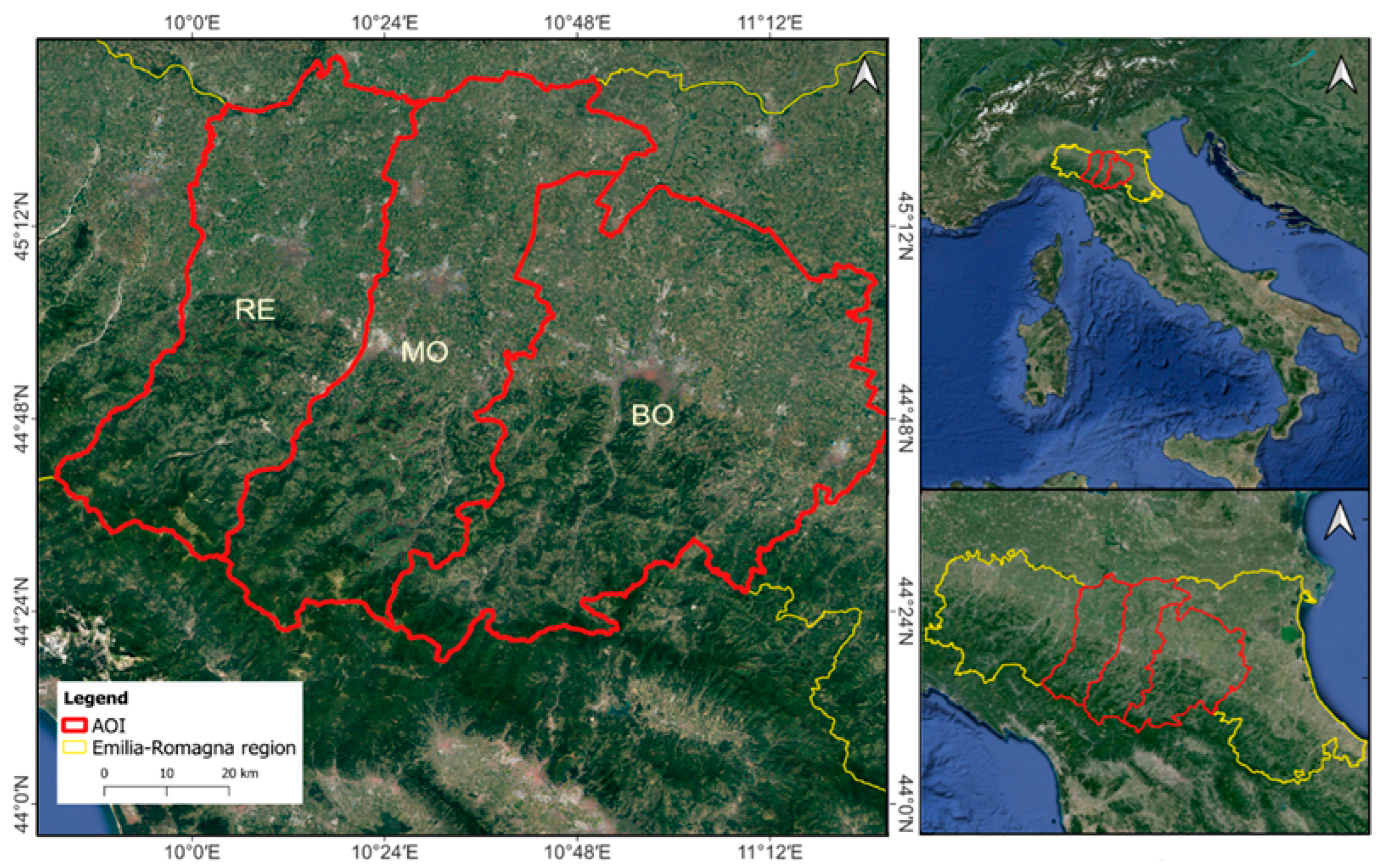
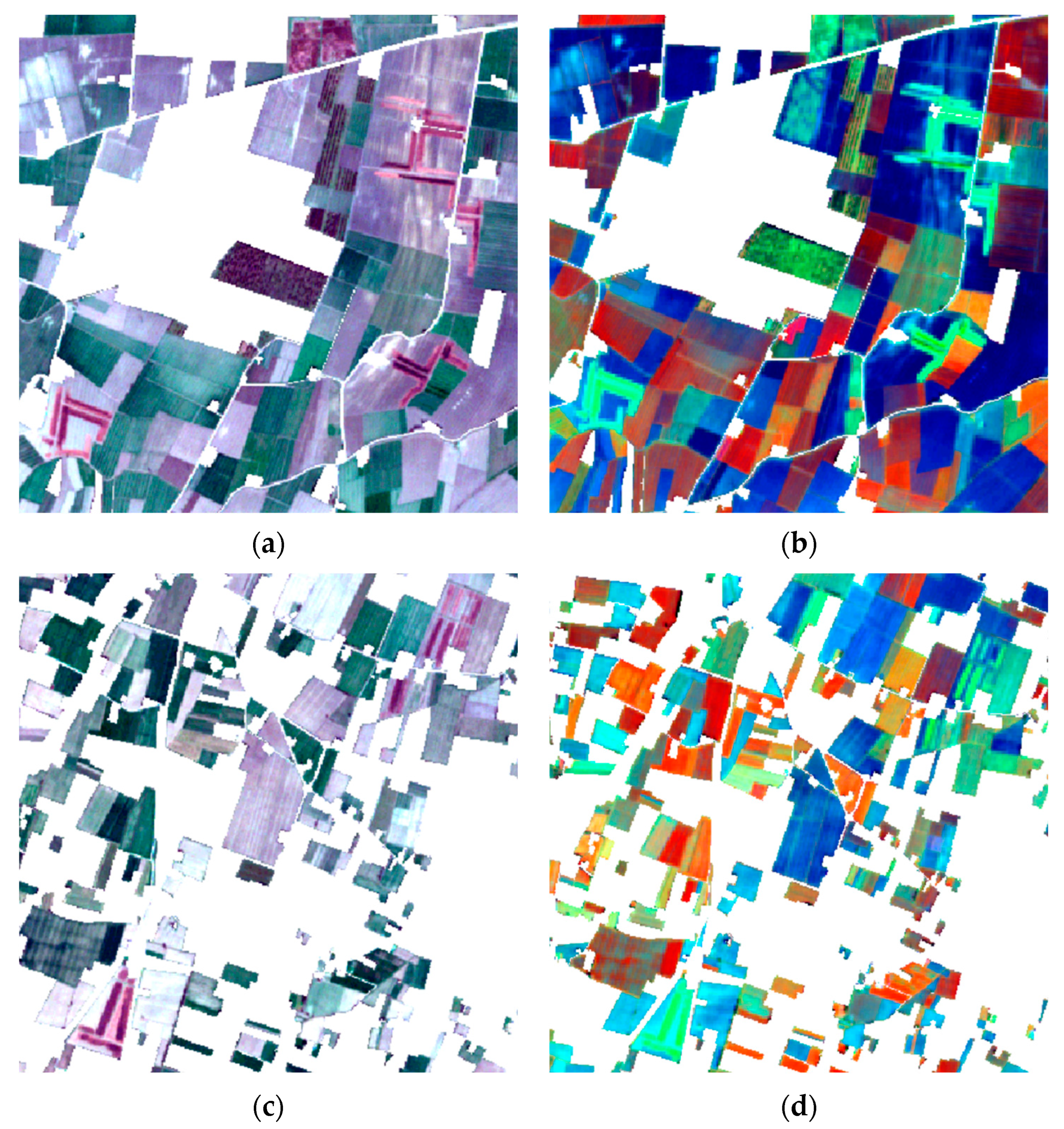

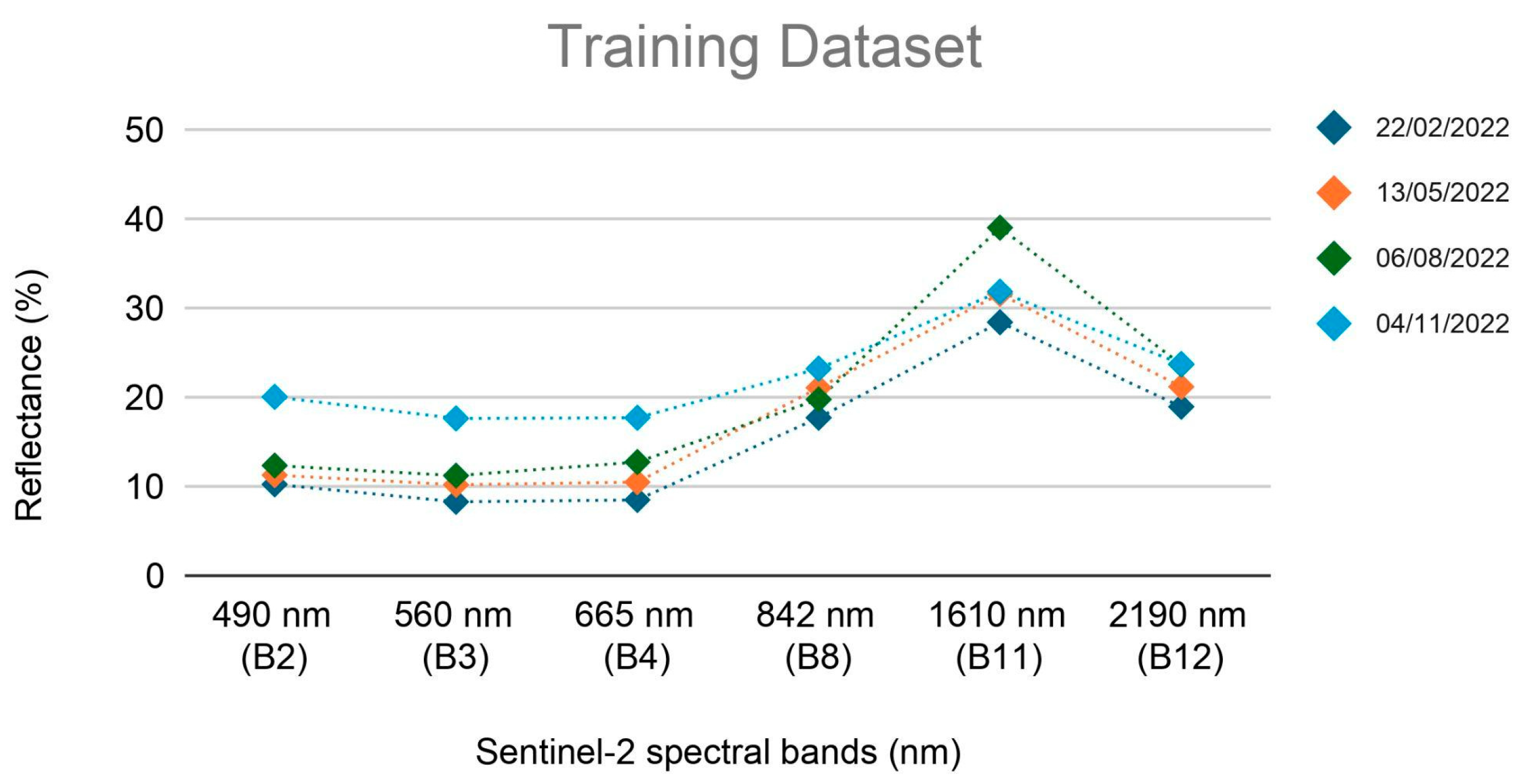

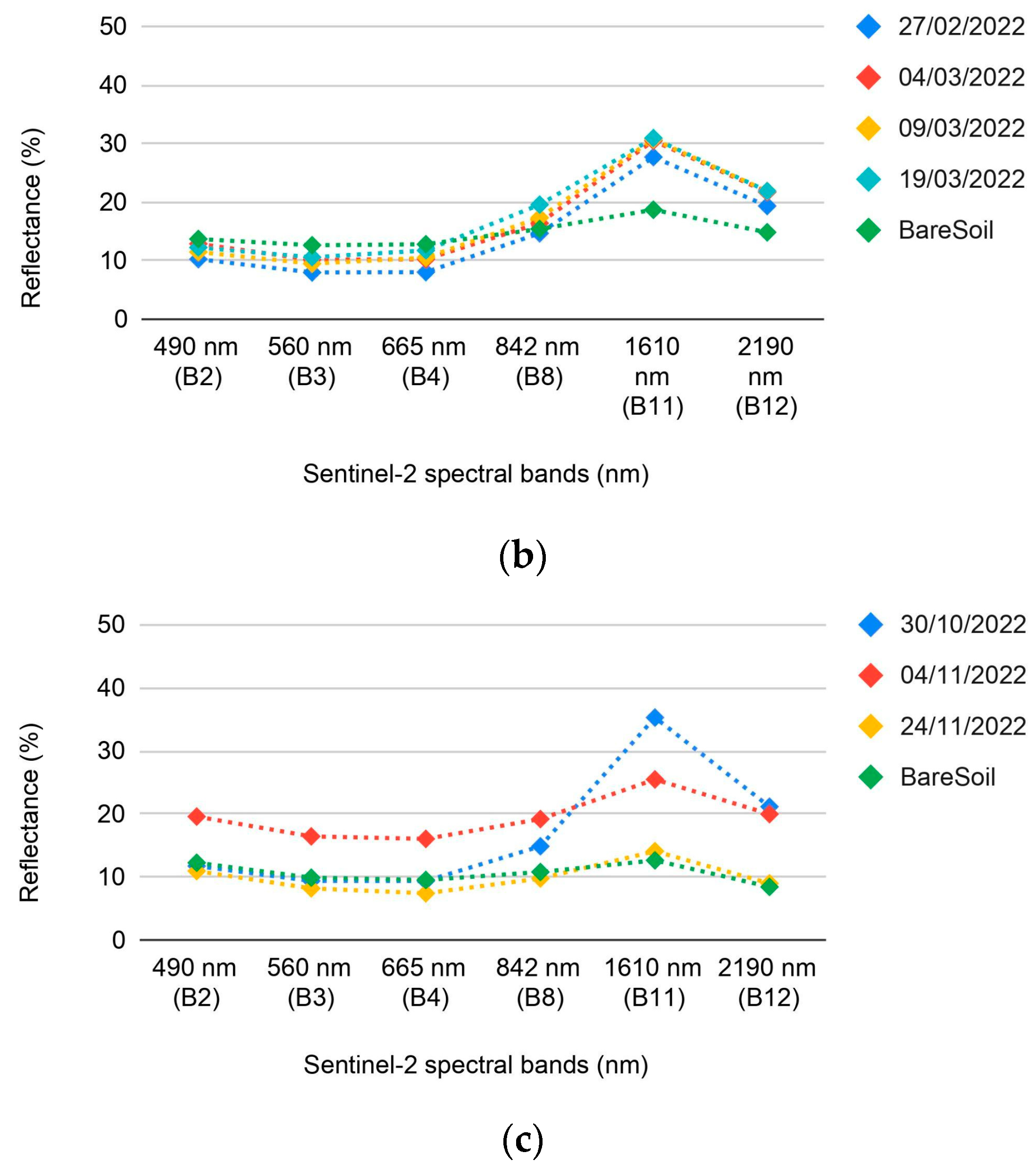
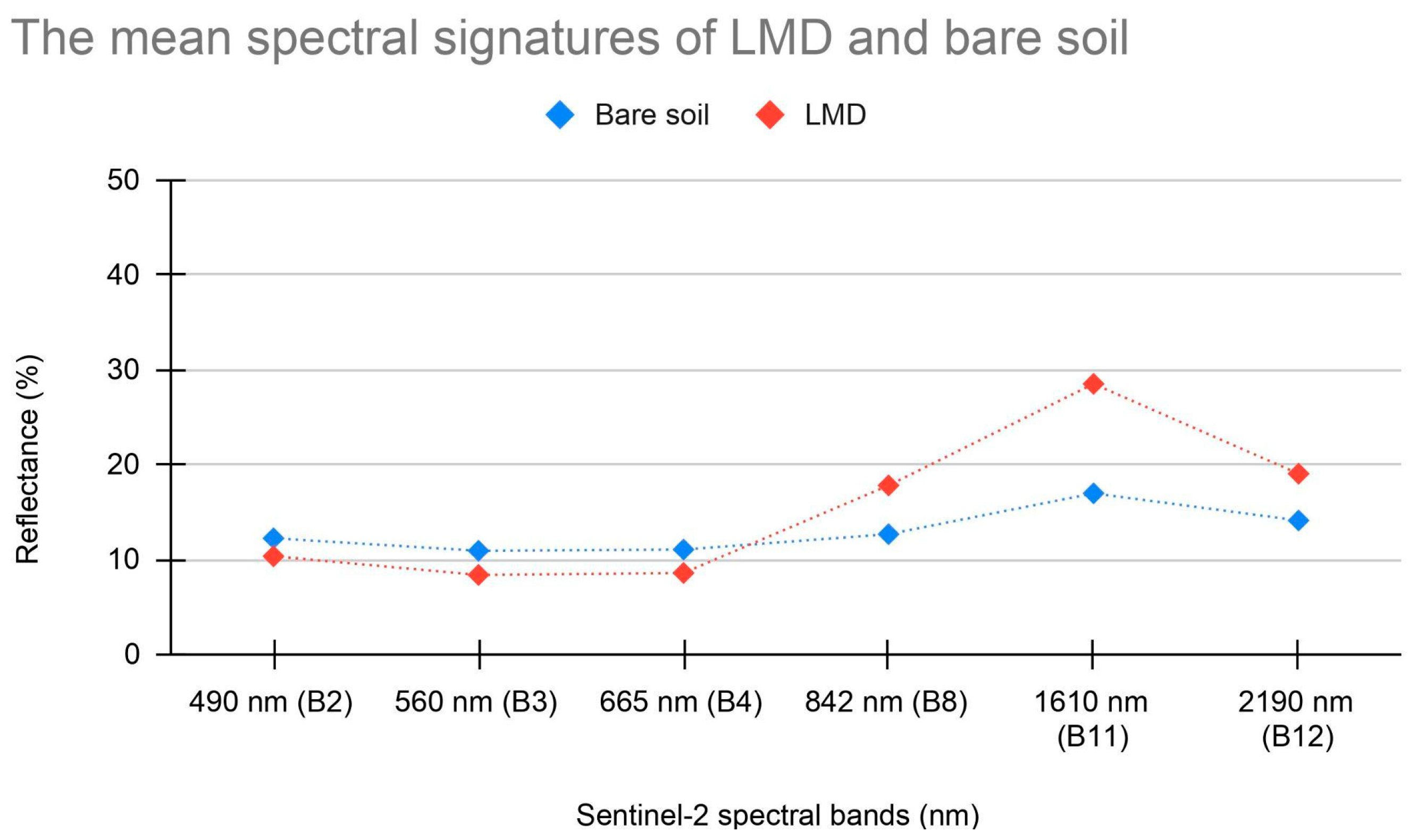
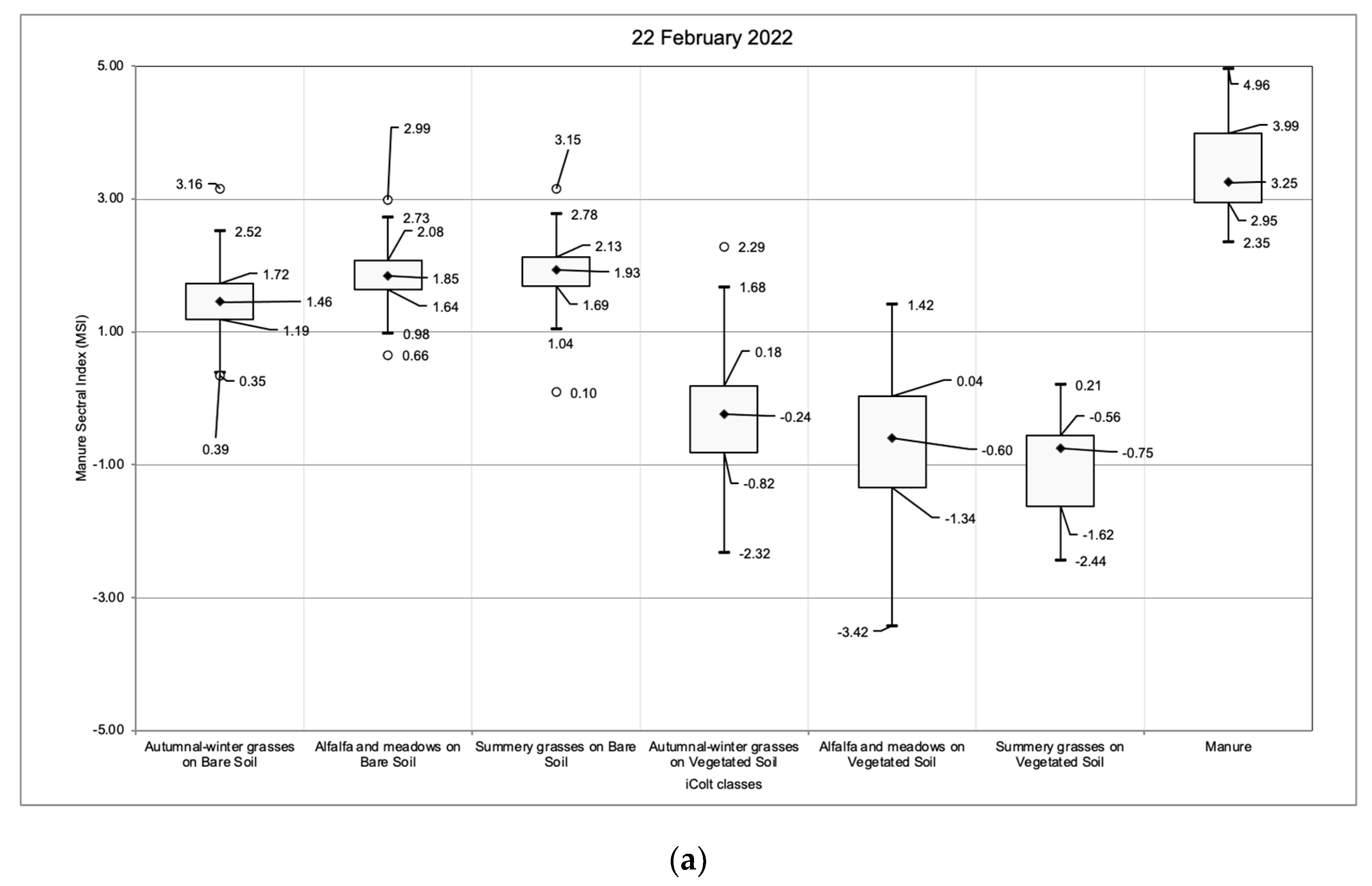



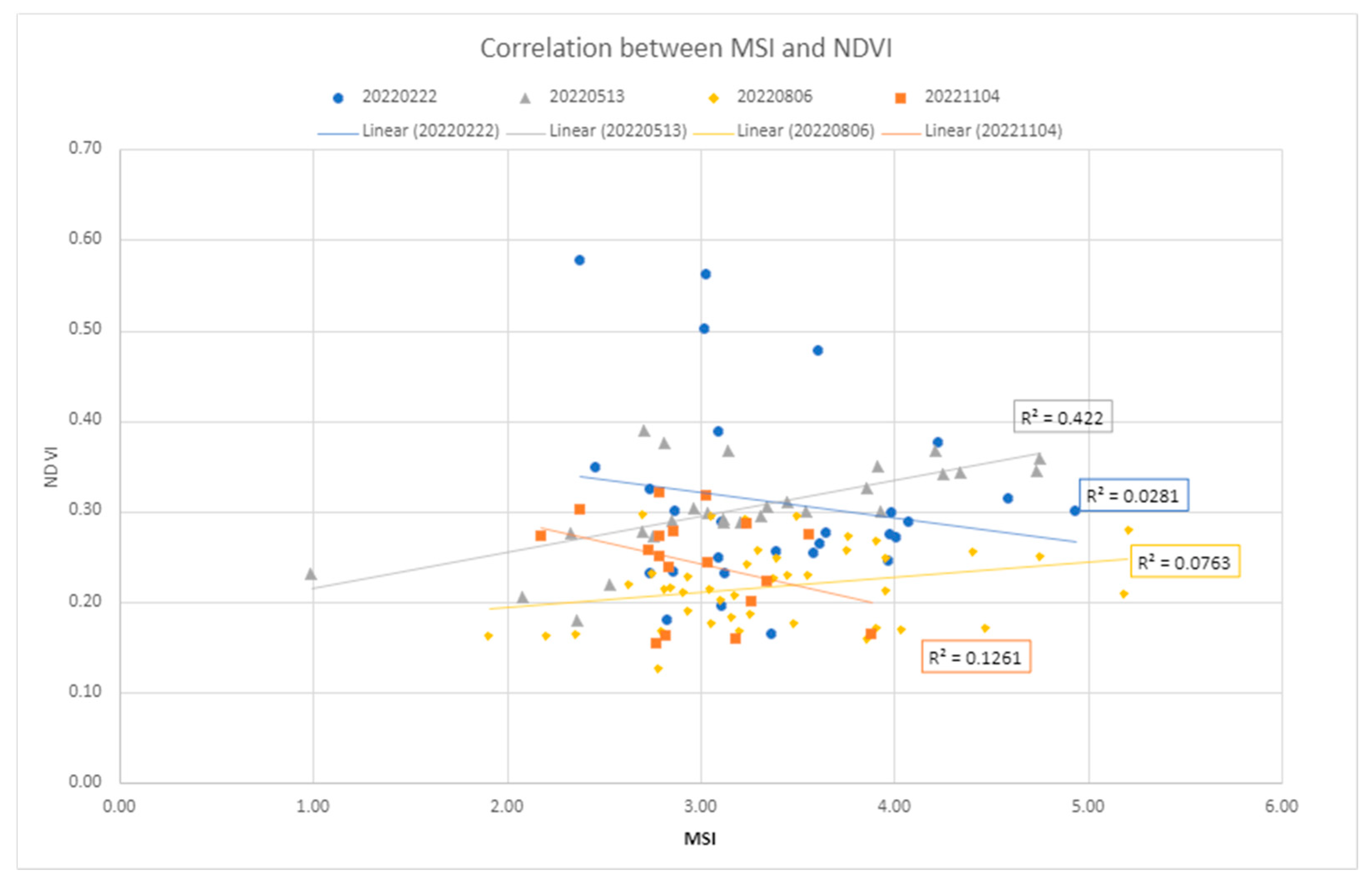
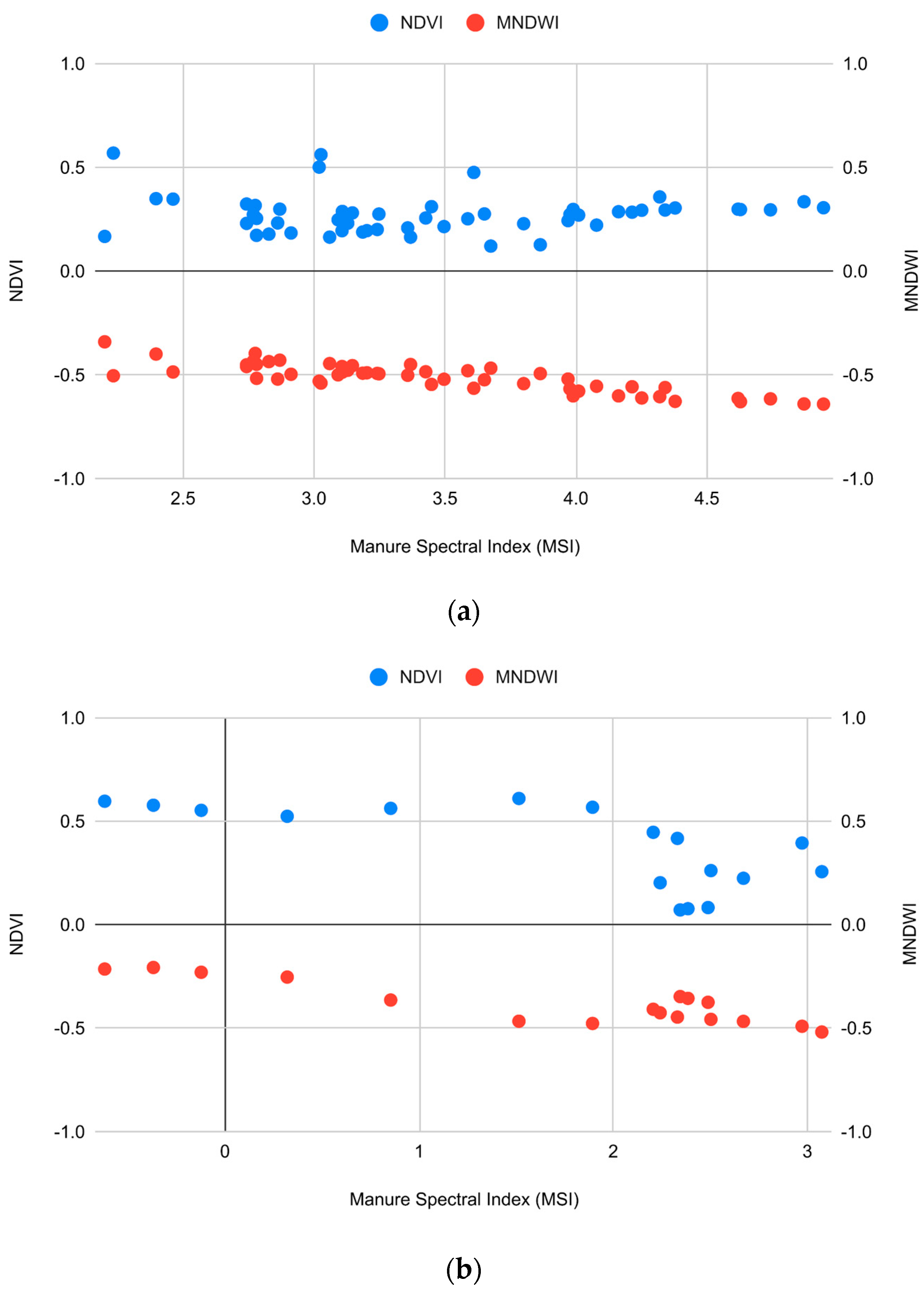
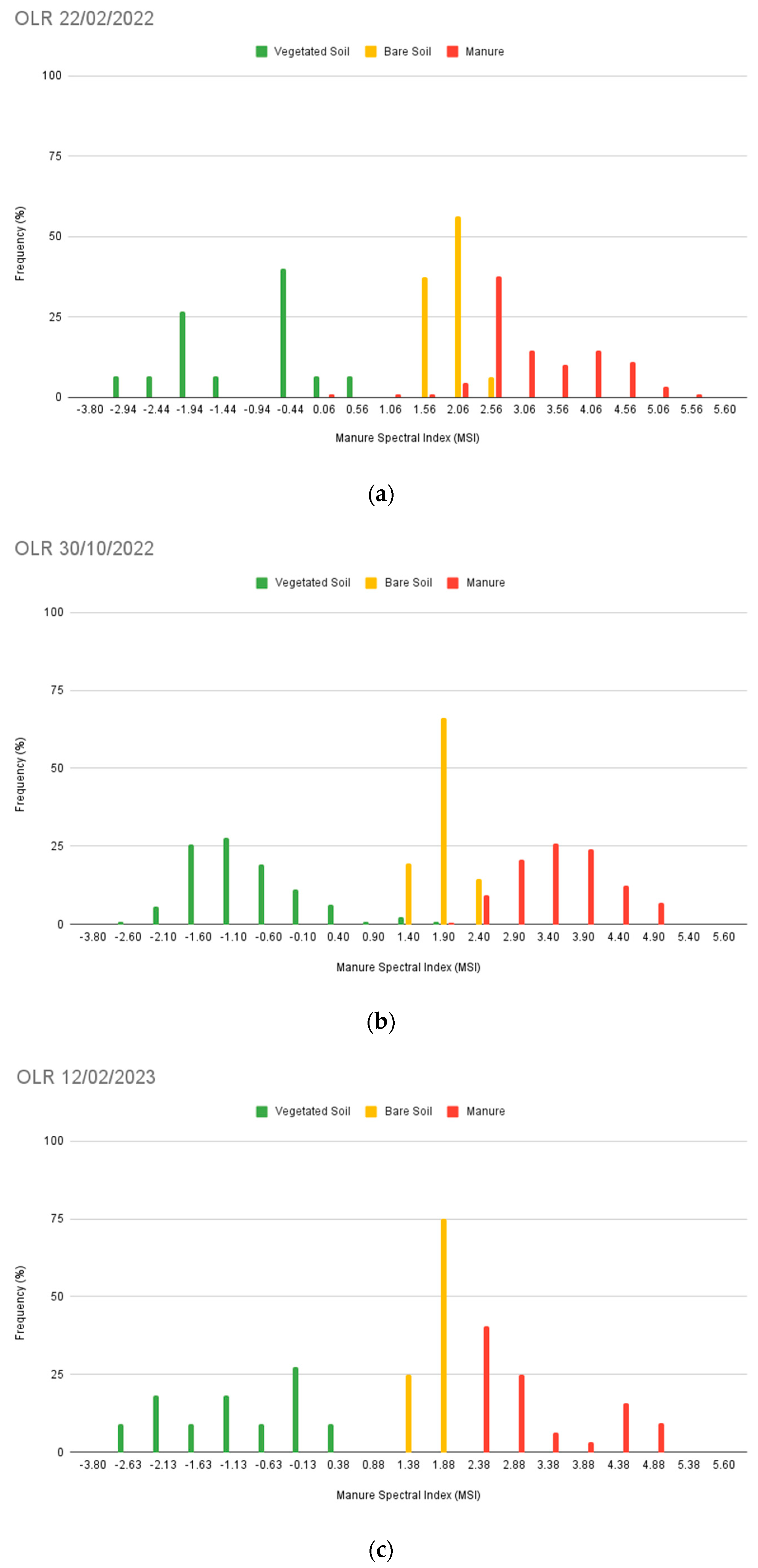
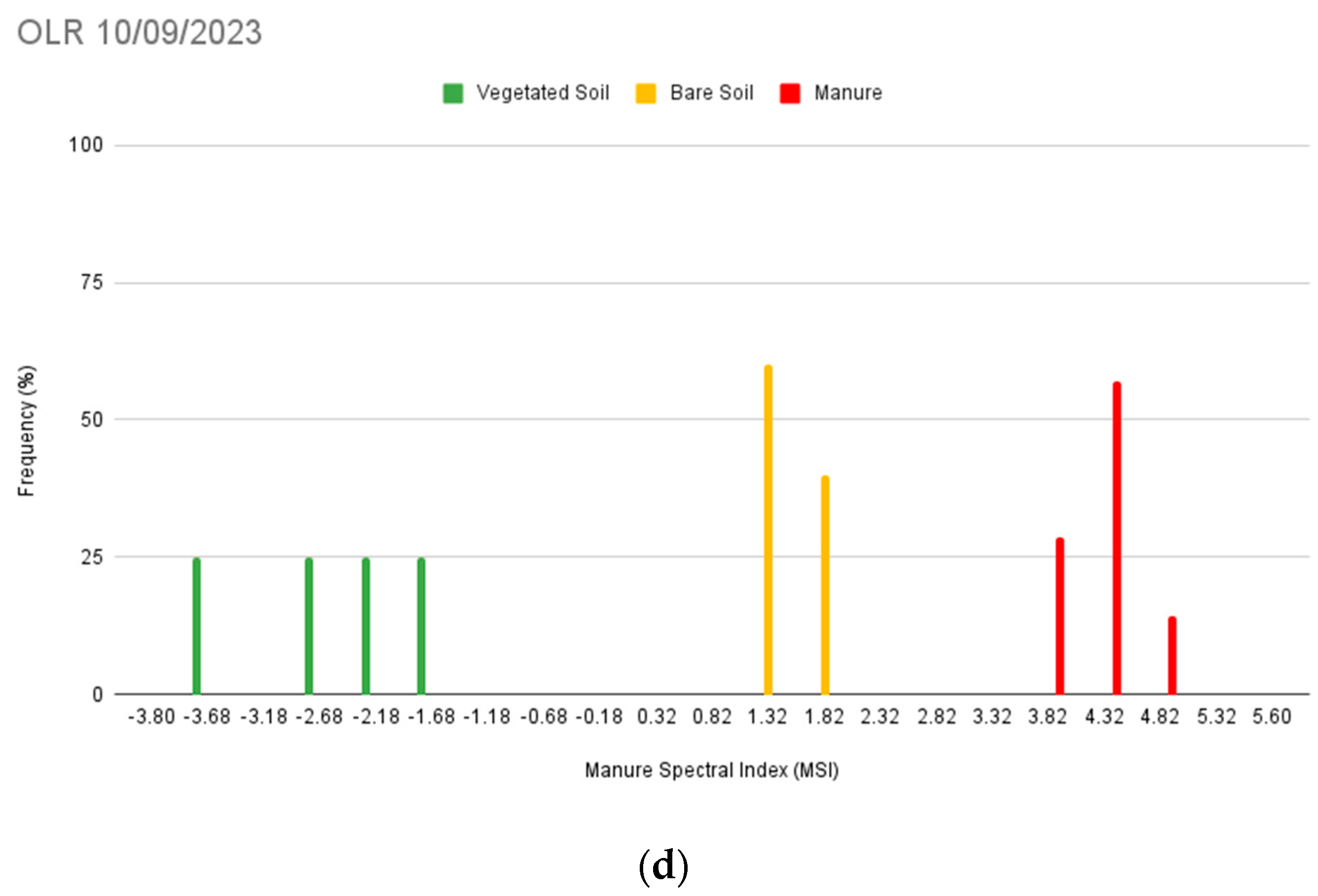
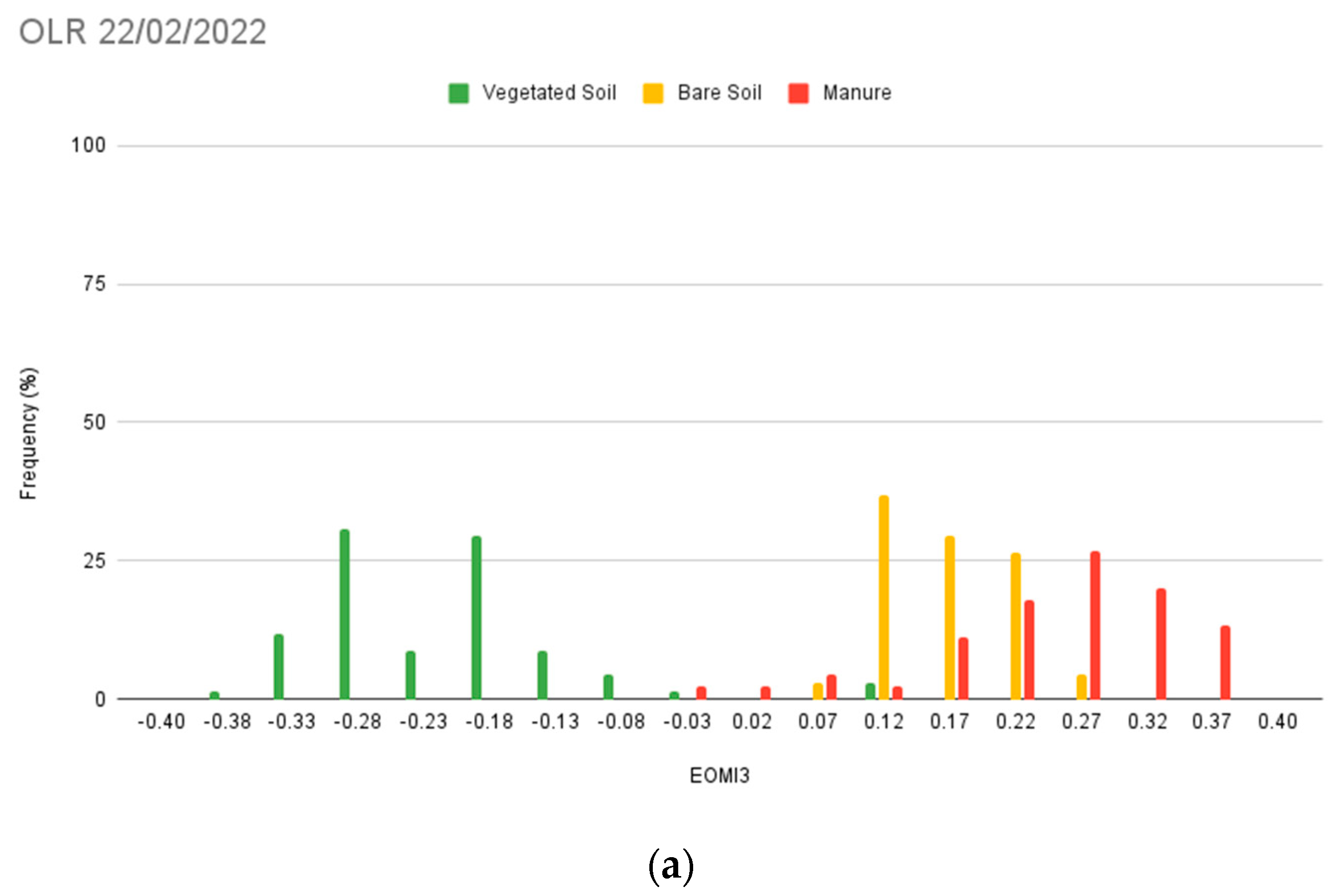
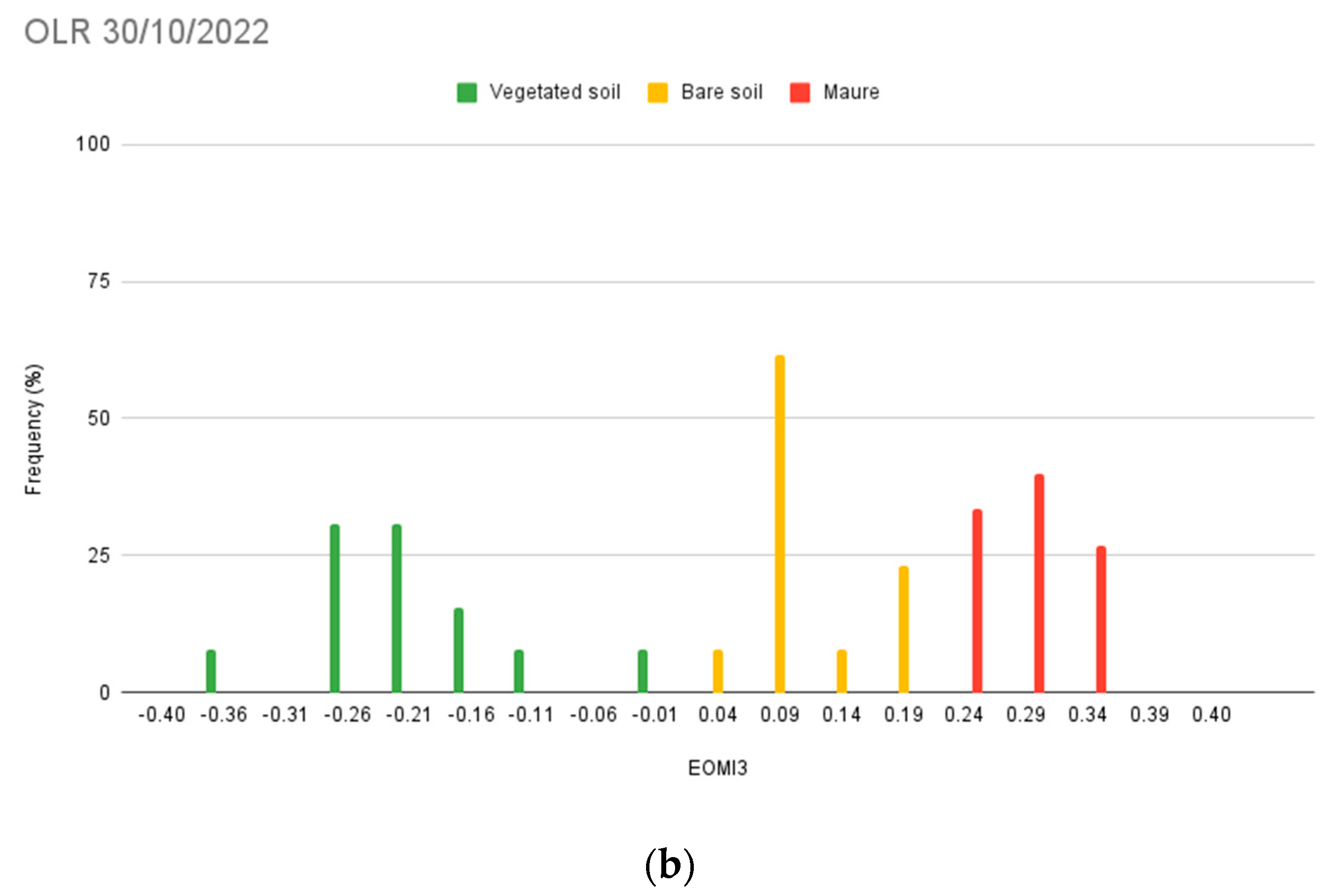

| Acquisition Date | Application | Soil Condition 1 | Satellite | Resolution | Cloud Cover% |
|---|---|---|---|---|---|
| 22 February 2022 | Training Dataset | Dry | Sentinel-2 L1C | 10 m | ≤6 |
| 13 May 2022 | Dry | ||||
| 6 August 2022 | Dry | ||||
| 4 November 2022 | Moist | ||||
| 27 February 2022 | Manure Spectral Signature Evolution | Dry | |||
| 4 March 2022 | Dry | ||||
| 9 March 2022 | Dry | ||||
| 19 March 2022 | Dry | ||||
| 30 October 2022 | Dry | ||||
| 4 November 2022 | Moist | ||||
| 24 November 2022 | Wet | ||||
| 30 October 2022 | Validation Dataset and Accuracy | Dry | |||
| 22 February 2022 | Dry | ||||
| 12 February 2023 | Dry | ||||
| 10 September 2023 | Dry | ||||
| 6 June 2022 | Bare Soil Analysis | Dry | |||
| 11 August 2022 | Dry | ||||
| 16 August 2022 | Dry | ||||
| 21 August 2022 | Dry | ||||
| 26 August 2022 | Dry | ||||
| 5 September 2022 | Dry |
| Acquisition Dates | Bare Soil LMD | Vegetated Fields LMD | Bare Soil Vegetated Fields |
|---|---|---|---|
| 22 February 2022 | 1.982 | 1.997 | 1.999 |
| 13 May 2022 | 1.987 | 1.987 | 1.999 |
| 6 August 2022 | 1.902 | 1.999 | 1.999 |
| 4 November 2022 | 1.958 | 1.999 | 2.000 |
| Ground Truth (Pixel) | ||||
|---|---|---|---|---|
| Other Classes | LMD | Total | ||
| MSI Index (Pixels) | Other Classes | 10,957 | 1951 | 12,908 |
| LMD | 0 | 3256 | 3256 | |
| Total | 10,957 | 5207 | 14,213 | |
| Overall Accuracy | 87.93% | K Coefficient | 0.71 | |
| Product Accuracy | User Accuracy | Commission | Omission | |
| LMD | 62.53% | 100.00% | 0.00% | 0.37% |
Disclaimer/Publisher’s Note: The statements, opinions and data contained in all publications are solely those of the individual author(s) and contributor(s) and not of MDPI and/or the editor(s). MDPI and/or the editor(s) disclaim responsibility for any injury to people or property resulting from any ideas, methods, instructions or products referred to in the content. |
© 2024 by the authors. Licensee MDPI, Basel, Switzerland. This article is an open access article distributed under the terms and conditions of the Creative Commons Attribution (CC BY) license (https://creativecommons.org/licenses/by/4.0/).
Share and Cite
Dubbini, M.; Belluzzo, M.; Zanni Bertelli, V.; Pirola, A.; Tornato, A.; Alessandrini, C. The Identification of Manure Spreading on Bare Soil through the Development of Multispectral Indices from Sentinel-2 Data: The Emilia-Romagna Region (Italy) Case Study. Sensors 2024, 24, 4687. https://doi.org/10.3390/s24144687
Dubbini M, Belluzzo M, Zanni Bertelli V, Pirola A, Tornato A, Alessandrini C. The Identification of Manure Spreading on Bare Soil through the Development of Multispectral Indices from Sentinel-2 Data: The Emilia-Romagna Region (Italy) Case Study. Sensors. 2024; 24(14):4687. https://doi.org/10.3390/s24144687
Chicago/Turabian StyleDubbini, Marco, Maria Belluzzo, Villiam Zanni Bertelli, Alessandro Pirola, Antonella Tornato, and Cinzia Alessandrini. 2024. "The Identification of Manure Spreading on Bare Soil through the Development of Multispectral Indices from Sentinel-2 Data: The Emilia-Romagna Region (Italy) Case Study" Sensors 24, no. 14: 4687. https://doi.org/10.3390/s24144687








